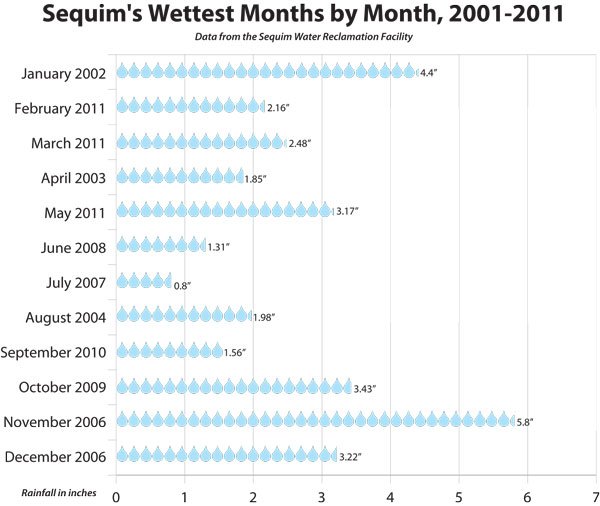by MATTHEW NASH
Sequim Gazette
Ask the farmers and they’ll tell you 2011 was a bad year for weather.
Find a tourist and you’ll get an earful about rain during Sequim’s two biggest events — the Irrigation Festival and Lavender Weekend.
The data backs up both of those grim recollections. The Sequim Water Reclamation Facility, which lies a few miles east of downtown Sequim, reports 2011 was the wettest year in 10 years, with 19.76 inches of precipitation.
Depending on where you stand, precipitation varies greatly thanks to the Olympic Rainshadow. Carlsborg had 15.26 inches of precipitation in 2011, whereas Bell Hill had 19.08 inches, according to www.wunderground.com, which reports several weather stations in the area.
Washington State University’s service AgWeatherNet, www.weather.wsu.edu, near the Water Reclamation Facility, reports 17.22 inches in 2011.
David Britton, operator of www.olympicrainshadow.com, reports that his weather station on Jamestown Beach Road saw 14.91 inches of rain last year.
The winter has been relatively dry except for the recent snowfall. compared to years past. Local farmers like Nash Huber, owner of Nash’s Organic Produce remained optimistic in interviews before
the forecasted snow.
Wet weather prevented his crews from getting into fields to prepare the harvest for about a month in 2011.
“We’ve had a series of later springs getting cooler,” Huber said. “This year (2011) was the worst.”
His popular staples — leafy greens, carrots, cabbage and brassicas — had an OK year, Huber said. In wet conditions, he tends to avoid or grow fewer of warmer weather vegetables like sweet corn, pumpkins and squash.
Steve Ragsdale, co-owner of Sunshine Herb & Lavender Farm, said the bad weather was a major factor for lavender farms across the U.S. as well as in Sequim.
“We had an extreme amount of rain, which is very adverse for lavender,” Ragsdale said.
Lavender plants typically prefer chalky, less-than-ideal soil with arid conditions. Cold temperatures typically are not a problem, but when the weather freezes and warms up and freezes, as it did in 2011, the plant can’t get into its dormancy.
Many local farms lost lavender plants because of this problem, but Ragsdale said his lost plants were set for replacement anyway. The new plants should produce this summer.
The sunshine in August led lavender to bloom later in the season along with local produce.
Ragsdale said his lavender plants are mounted for more drainage to help the moisture leave the roots.
“We’ve very optimistic and have a lot of new programs we’re moving forward with. We are continuing to highlight Sequim-Dungeness lavender as the premier lavender in the world,” Ragsdale said.
“We have a decent chance for a decent summer judging by the ways things are going now,” Huber said. “One thing that I’m amazed by is that the weather can turn on a dime.”
“I wish there was something I could do about it,” Huber joked.
Reach Matthew Nash at mnash@sequimgazette.com.


